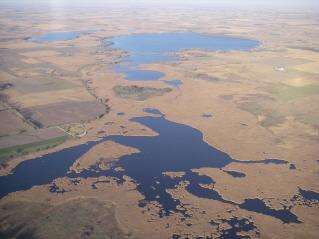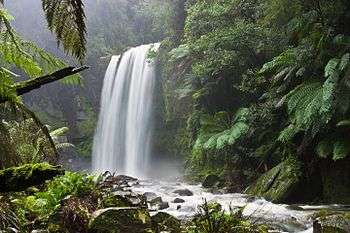Ducks Unlimited
 | |
| Founded | 1937 |
|---|---|
| Founder | Joseph Knapp |
| Type | Habitat Conservation and Hunting |
| Focus | waterfowl habitat conservation |
| Location | |
Area served | North America |
Members | 700,000 |
Key people |
Paul Bonderson, President; Dale Hall, CEO [1] |
Volunteers | 40,000 |
| Website | www.ducks.org |
Ducks Unlimited (DU) is an American nonprofit organization 501(c) dedicated to the conservation of wetlands and associated upland habitats for waterfowl, other wildlife, and people. It had roughly 700,000 members as of January 2016.[2]
Introduction
In 1927, an offshoot of the Boone and Crockett Club was created specifically for sport bird management and operated until 1930 as the American Wild Fowlers. Membership included such people as Arthur Bartley and Nash Buckingham, who would later be very instrumental in the conservation movement. In 1930, Joseph P. Knapp, a publishing tycoon who successfully obtained such notable publications as The Associated Sunday Magazine, Crowell Publishing Company, Collier’s Weekly, Farm and Fireside and the book publisher P.F. Collier & Sons, founded More Game Birds in America and American Wild Fowlers was quickly absorbed into the new organization.
In 1937, Knapp, Robert Winthrop, and a small group of conservation philanthropists decided to focus on the decreasing waterfowl populations, and the habitat necessary to sustain them in Canada, and formed Ducks Unlimited Inc. As had happened before, More Game Birds in America was absorbed by the new waterfowl organization.[3][4][5]
Ducks Unlimited Canada was incorporated in Winnipeg, Manitoba, Canada, on March 10, 1937.[6] Ducks Unlimited also works in Mexico through their sister organization Ducks Unlimited de Mexico. Other chapters have since begun operation in Latin America, Mexico, New Zealand, and Australia.[7]
DU has conserved more than 13.8 million acres of waterfowl habitat in North America.[8] DU partners with a wide range of corporations, governments, other non-governmental organizations, landowners, and private citizens to restore and manage areas that have been degraded and to prevent further degradation of existing wetlands. DU is also active in working with others to recommend government policies that will positively influence wetlands and the environment. DU generated more than $235 million in revenues during their last fiscal year,[8] of which a minimum of 80 percent goes directly toward habitat conservation.[9] Their sources of revenue include federal and state habitat reimbursements, conservation easements, sponsors and members, major gifts and donations and royalties/advertisement. Through its conservation activities, DU benefits biodiversity, water quality, the environment and the economy in the areas in which it is active.
Ducks Unlimited, in keeping with its founders' intentions, also promotes the continuation of safe and regulated waterfowl hunting. The majority of DU's financial contributors and members are waterfowl hunters, and over 90 percent of those who read DU's magazine are hunters. The DU magazine contains many historical and practical articles on waterfowl hunting, and it obtains revenue from advertisements of waterfowling equipment such as shotguns, ammunition, decoys, and bird calls.
Conservation
Traditionally, most DU wetland conservation projects were conducted on waterfowl breeding areas in the Canadian prairies by its subsidiary, Ducks Unlimited Canada (DUC). DUC has however expanded its operations to include projects in every Canadian province and territory, not just in the prairies. DU has also expanded its operations to include conservation projects in every state of the United States and in Mexico. It retains primary focus on habitats most important to waterfowl; including the restoration of duck breeding habitat in Canada and the northern central states, and also duck overwintering habitat, mostly in the coastal and southern states and in Mexico.
Methods
Ducks Unlimited places strong emphasis on science and research. It works closely with biologists and ecologists to evaluate habitat needs and to monitor how birds respond to various environmental changes. Some of the methods used by Ducks Unlimited to conserve habitats are:[10]
- Restoring grassland
- Grassland cover helps hens conceal their nests and increases their chances of successfully hatching a clutch, as well as increases sexual productivity and heightens the chance of producing offspring.
- Replanting forests
- Forests that flood regularly due to overflowing riverbanks, such as the bottomland hardwood forests in the Mississippi Alluvial Valley make for ideal wintering habitat for ducks, and provide essential breeding and foraging habitat for other wildlife species. However, 80% of these forests have been cleared and natural flooding has been reduced by 50–90%.
- Restoring watersheds
- When watersheds are disturbed, contaminants wash into wetlands and disrupt the plants, fish and animals. DU restores drained wetlands, protects stream corridors and establishes buffer strips that filter nutrients and silt.
- Educating landowners
- DU works with farmers, ranchers and other landowners to improve the agricultural and recreational value of their land while making it more wildlife-friendly.
- Conservation easements
- Conservation easements protect the natural resource values of a property in perpetuity. The landowner maintains actual ownership of the land, but agrees to certain development restrictions. Since 75% of U.S. wetlands are on private property, conservation easements play a crucial role in the conservation movement.
- Acquiring land
- The direct purchase of wetlands to restore and protect it. Once restoration is complete, DU generally sells or donates the property to a group or agency that will manage it for wildlife.
Ducks Unlimited also works closely with government leaders, conservation leaders, private landowners and farmers to ensure that environmental provisions are contained in the Farm Bill. The Farm Bill supports programs such as the Conservation Reserve Program (CRP) and Wetlands Reserve Program (WRP).
Regions of special interest

Ducks Unlimited takes a continental, landscape approach to wetland conservation. While DU works in all 50 states, the organization focuses its efforts and resources on the habitats most beneficial to waterfowl and in greatest jeopardy of disappearing. The following areas are considered to be DU's top 5 conservation priorities:[9]
- Prairie Pothole Region[11]
- Western Boreal Forest of Canada [12]
- Mississippi Alluvial Valley[13]
- Central Valley and Coastal California[14]
- Gulf Coastal Prairie[15]
Ducks Unlimited TV
Ducks Unlimited produces a television show, Ducks Unlimited TV a.k.a. DUTV. This show is hosted by Field Hudnall, Wade Bourne and Ainsley Beeman and highlights conservation and waterfowl hunting from across the United States.[16]
See also
References
- ↑ "DU National Staff & Board of Directors". Ducks.org. Retrieved 2013-01-15.
- ↑ http://www.ducks.org/media/_global/_documents/stateFactSheets/NationalFactSheet.pdf
- ↑ Boone and Crockett Club
- ↑ Bolen, Eric (April 2000). "Waterfowl Management: Yesterday and Tomorrow". The Journal of Wildlife Management. The Journal of Wildlife Management. 64 (2): 323–335. doi:10.2307/3803230. JSTOR 3803230.
- ↑ Boone and Crockett Club Archives
- ↑ "Ducks Unlimited". Ducks Unlimited. 76 (1): 10. January–February 2012.
- ↑ "Ducks Unlimited's International Programs". Ducks Unlimited. Archived from the original on 2007-04-28. Retrieved 2007-06-25.
- 1 2 Jones, Lindsay (Fall 2012). "Ducks in a Row". Philanthropy. Retrieved 8 January 2013.
- 1 2 "National Fact Sheet" (PDF). Ducks Unlimited. Retrieved 8 January 2013.
- ↑ "How DU Conserves Wetlands and Waterfowl". Ducks Unlimited. Retrieved 8 January 2013.
- ↑ "Prairie Pothole Region". Ducks.org. Retrieved 2013-01-15.
- ↑ "Western Boreal Forest - Canada". Ducks.org. Retrieved 2013-01-15.
- ↑ "Mississippi Alluvial Valley". Ducks.org. Retrieved 2013-01-15.
- ↑ "Central Valley / Coastal California". Ducks.org. Retrieved 2013-01-15.
- ↑ "Gulf Coastal Prairie". Ducks.org. Retrieved 2013-01-15.
- ↑ "Watch the best outdoor shows for free on CarbonTV". CarbonTV. Retrieved 2016-02-08.
External links
- Ducks Unlimited
- Ducks Unlimited Canada
- Ducks Unlimited Louisiana
- Official Ducks Unlimited TV CarbonTV Channel
